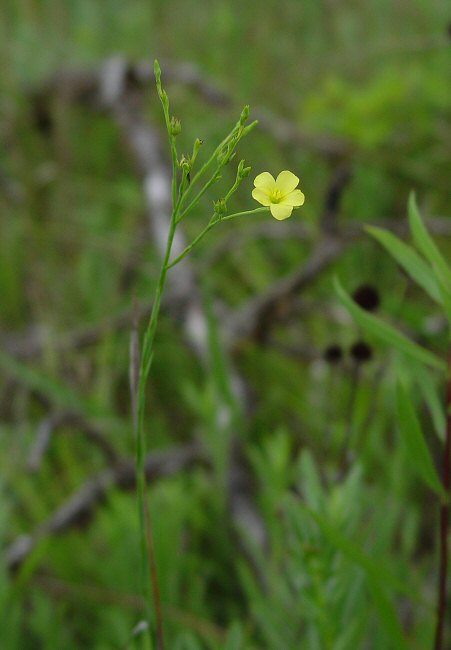Linum sulcatum Riddell
Grooved Yellow Flax

Native
CC = 5
CW = 5
MOC = 35
© SRTurner
Linum sulcatum RiddellGrooved Yellow Flax | |
 |
Native CC = 5 CW = 5 MOC = 35 |
© SRTurner |
|
Family - Linaceae Habit - Taprooted annual forb. Stems - Ascending to erect, to 85 cm, solitary, often branching near the apex, glabrous, usually with fine longitudinal lines but not prominently ridged, terete.
Leaves - Alternate, simple, sessile. Stipules sessile glands, visible as a pair of small dark dots at the leaf base. Blades 2.0-2.7 cm long, 2-3 mm wide, linear to linear-lanceolate, tapered to a sharply pointed tip, with single midrib, the margins entire (sometimes the bracteal leaves in the inflorescence with inconspicuous glandular teeth), the surfaces and margins glabrous.
Inflorescence - Terminal and axillary loose panicles or racemes. Each flower subtended by a foliaceous bract. Bracts glandular-serrulate. Pedicels glabrous, 2-3 mm in flower, slightly elongating in fruit to 4-5 mm.
Flowers - Sepals 3.5-7 mm long, lanceolate to narrowly lanceolate, those of both inner and outer whorls with prominent glandular teeth along the margins. Petals 5, glabrous externally, pubescent near base internally, 5-6 mm long, pale yellow to light yellow. Stamens 5, erect. Filaments scarious, compressed and united at base into short tube under the ovary, glabrous, 4 mm long, slightly yellowish near the apex. Styles 5, fused for about 1 mm at the base, 3-5 mm long. Ovary superior, green, 5-locular, (1-2 ovules per locule), glabrous, globose-ovoid, 1.5 mm in diameter.
Fruits - Capsules 2.5-3.5 mm long, 2-3 mm in diameter, globose to somewhat ovoid, readily shattering at maturity and breaking into 10 mericarps, each 1-seeded, more or less rounded across the dorsal surface, the septa moderately to densely hairy along the ventral margins, the mature fruits lacking purple stripes. Seeds 1.5-2.1 mm long, reddish brown.
Flowering - May - September. Habitat - Glades, prairies, upland forest openings. Origin - Native to the U.S. Other info. - This little plant is inconspicuous when not in flower but is still easy to identify from the pair of opposing, blackish glands at the base of each leaf. These are sufficient to uniquely identify the plant to species; however, they are tiny and most readily observed using a hand lens. The plant is found in a number of counties scattered across Missouri, most commonly in the southwestern quadrant of the state. Its main range beyond Missouri falls within a vertical band in the central part of the continental U.S. Photographs taken at the Peck Ranch Wildlife Refuge, Reynolds County, MO., 7-7-01, and at Busiek State Forest, MO., 6-17-05 (DETenaglia); also at Victoria Glade Conservation Area, Jefferson County, MO, 8-19-2020; Glade Top Trail National Scenic Byway, Ozark County, MO, 8-16-2023, and Twenty-Five Mile Prairie, Polk County, MO, 8-6-2024 (SRTurner). |